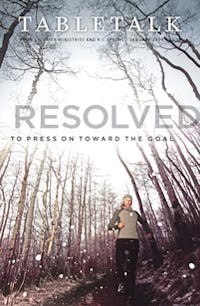
Request your free, three-month trial to Tabletalk magazine. You’ll receive the print issue monthly and gain immediate digital access to decades of archives. This trial is risk-free. No credit card required.
Try Tabletalk NowAlready receive Tabletalk magazine every month?
Verify your email address to gain unlimited access.
A modern reader perusing Jonathan Edwards’ “Resolutions” is likely to think, what about dieting? And, didn’t eighteenth-century New England have any gyms that he could resolve to join? Today, losing weight and getting more exercise are about the extent of our resolutions. We summon up our will-power, self-scrutiny, and self-discipline in an attempt to look better. Edwards was engaged in an attempt to be better.
Edwards’ effort at self-improvement, though — so strenuous as to engage “all the power, might, vigor, and vehemence, yea violence, I am capable of” — is that of a man wholly informed by the Word of God and the gospel of salvation by grace through faith in Jesus Christ. Edwards exercised his will while knowing that his will was in bondage. He resolved to be righteous, while knowing that his righteousness did not earn his salvation. He scrutinized himself, while knowing that his spiritual security resided outside himself — in the objective fact of Christ’s atonement for his sins.
Many of the puritans’ habits and habits of mind — their work ethic, their self-discipline, their moral seriousness — persisted long after the eclipse of their theology, to be taken up by Enlightenment secularists, social-gospel liberals, and Victorian materialists. Shortly after Edwards’ time, Benjamin Franklin started a similar program of resolutions and self-scrutiny. Franklin set forth thirteen resolutions — as opposed to Edwards’ seventy — that were built around rational virtues such as thrift, moderation, and chastity.
Whereas Edwards’ resolutions were focused on God’s glory, Scripture, heaven and hell, and Jesus Christ, Franklin’s were secular, pragmatic, and this-worldly, focused on becoming a good citizen and a successful businessman. Though Franklin does mention prayer, Christ is reduced to being a good example for him to follow, mentioned in the same breath as Socrates.
Franklin kept a chart upon which he made check marks indicating his progress. When he found that he had problems keeping them all at once, he tried concentrating on one virtue at a time. When he found that he was still not making all that much progress, he eventually gave up the whole plan.
Paying such attention to one’s self, when separated from a biblical self-examination designed to provoke repentance, would bear another kind of fruit: Romanticism.
American literature classes today study Jonathan Edwards not for his theology and not even just for his “Sinners in the Hands of an Angry God” sermon, with its hair-raising imagery, but as a precursor to the Transcendentalists.
Edwards saw spiritual meaning in nature, which, as God’s creation, he saw as an expression of the divine personality. Literary historians — missing the point of Edwards’ distinctly Christian worldview — interpret this as a step towards the Transcendentalists’ deification of nature.
Edwards also scrutinized his inner life, as he does in his “Resolutions,” and cultivated his inner emotions, which he associates with his spiritual state, as he does in his “Personal Narrative.” This is taken as a step towards the Transcendentalists’ deification of the self.
In reality, Edwards was very different from his fellow New Englander Ralph Waldo Emerson, the Unitarian mystic rhapsodizing about nature. Nor was he much like Walt Whitman, the great American poet who wrote an epic poem entitled “Song of Myself.” Rather, Edwards exemplifies the integrated Christian sensibility in which the spirit, the intellect, and the emotions each have their place. Later, in T.S. Eliot’s words, these human powers would become “dissociated” into the conflicting movements of the Enlightenment, Romanticism, and Modernism.
Edwards is certainly not to blame for the obsession with the self that characterizes American culture and even many strains of American Christianity. Our best-seller lists testify to our values of self-help, self-reliance, and self-improvement. Many of our pulpits resound with the slogans “be true to yourself,” “trust yourself,” and even “have faith in yourself.” If Edwards were to hear of such things, he would surely preach a sermon that would make “Sinners in the Hands of an Angry God” seem like a devotion for Vacation Bible School.
But even conservative Christians can sometimes fall into the trap of paying too much attention to themselves. “Am I really saved?” we can sometimes wonder, looking at our inner lives and hidden sins and finding all too little evidence of our holiness.
We have to admit that our own resolutions to improve our lives, however well-intentioned and sincerely meant, often have little effect. We cannot even keep our resolutions to lose weight or work out at the gym, much less eliminate our sins of lust and cruelty.
Surely Edwards would agree with Martin Luther, who, in his spiritual counseling, would urge tormented souls to stop looking at themselves. Instead, they should look outside themselves to Christ on the cross.
Salvation, both would insist, is extra nos (outside ourselves), founded on the unshakable grace of God and on the objective work of Christ. When we look inside ourselves we see our sin and our weakness, leading us only to despair. But when we look outside ourselves to the promises in God’s Word, we can find joy, confidence, and assurance.
